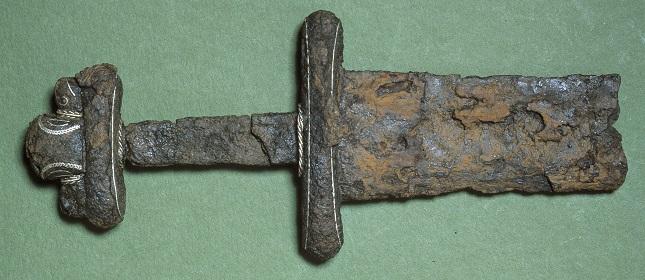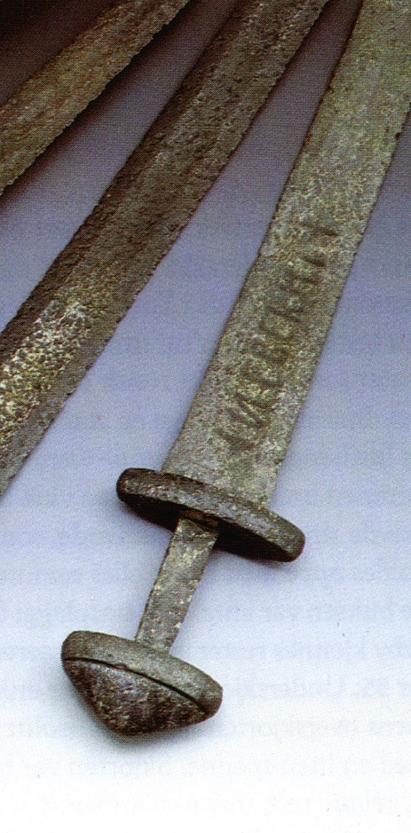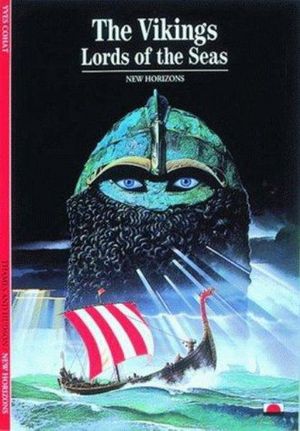


Source: Jonathan Chng (2018)
The Vikings were known as formidable warriors, striking fear into the hearts of the towns they raided. Read through these resources to learn more about the armour and weapons the Vikings used, and the battle tactics they used in war and on raids.
Head armour of the period consisted of helmets sometimes including a mail coif. Helmets were made in a variety of ways and from several materials, with the single objective of deflecting or completely withstanding a blow from a sword.
This article discusses examples of Viking shields found in archaeological digs, including how they were made and decorated.
As well as their ships, weapons are also popularly associated with the Vikings. Indispensable on plundering raids and for self-defense, they were an important part of the daily lives of Scandinavians. We are familiar with a number of types of weapons, which demonstrate how war was waged 1000 years ago. Archaeologists find them in graves, lakes, near fords and at battlefields from the Viking period. Each find is a small piece in the large jigsaw puzzle of Viking warfare.
Our knowledge of Viking weapons comes chiefly from archaeological finds. Weapons were often buried with their owner as grave goods, and offerings of weapons – probably made to one of the many Scandinavian war gods – were deposited in bogs and lakes, where they can be recovered today. Literary sources help to round out the picture.
A Viking raid nearly always came as a total surprise. This article describes how Vikings were so successful at conducting raids across Europe.
This website provides a list of major Viking military confrontations, occupations and explorations. It is not comprehensive, but will give you an idea of just how successful the Vikings were as raiders. The battles listed in red are the ones the Vikings won, the ones in black are the ones the Vikings lost.
This resource is about Viking conquests in the British Isles. It includes text and some images. The resource is organised under seven topic headings: Terror from the sea; Lindisfarne sacked; Who were the Vikings?; Ships and navigation; A fair wind for raiding; The need for more land; and Find out more.
In the early Viking period the basis of the army was the hirð (pronounced - heerth), the men of the lord's hearth who had sworn loyalty to him. Many would be fellow countrymen drawn by a lord's reputation for valour and generosity, but some would be professional fighters seeking the best rewards. In peacetime they acted as the lord's or king's officials, forming embassies, exacting tribute, recovering dues, and acting as messengers; in war they formed the core of his army. In addition the lord could call upon his estates to provide ships and crews (the coastal nature of Scandinavian warfare meant that armies were often calculated in terms of ships' crews). This article describes how the military was organised and the different names for different fighters.


The hilts of the swords were of various shapes and were made of bone, antler or precious metals such as gold and silver. The sword was an expensive weapon and therefore much effort was put into decorating its handle. The pommel, which acted as a counterweight to the blade so that the sword balanced, could display inlays of precious metals or intricate patterns. The blade itself often had “blood grooves” running along its middle. These saved valuable metal and made the sword lighter. The silver on the hilt is still visible.

Some of the finest sword blades that the Vikings could acquire were imported from the Rhine area. Their blades bore the name ”ULFBERTH”, which denoted the best swords of the time made of high quality steel. Ulfberth may have been the master, who was responsible for the production of these swords in the Frankish Empire during the 9th century. However, the swords were made up until the 11th century, so the name must subsequently have been used for the products of a particular workshop.
The Ulfberth swords became so popular that a ban had to be placed upon their export. This was imposed to limit the Vikings’ access to these quality swords, which they were using very effectively to ravage the coasts of the Frankish Empire. However, as a result smiths in territories neighbouring the Frankish Empire began to produce sword blades and copy the name ULFBERTH onto them. Both genuine and imitation ULFBERTH swords have been found throughout large parts of Europe. The imitations, however, are often of a distinctly lower quality than the genuine examples.

A rare find was made at Trelleborg, near Slagelse, in 2008. Archaeological excavations at the site uncovered an almost complete shield. This is made of pine wood and has a diameter of around 80 cm. Presumably the shield was used when the fortress was in operation at the end of the 900s. This is only the second site from Scandinavia that has produced one or more complete Viking shields. The shield was found in waterlogged conditions – which have resulted in it still being preserved today. It has a hole in the middle and a grip is also present. Originally a boss must have been attached in this part of the shield, but it was not found in the excavations.

The deceased magnate from Mammen was given a magnificent axe to accompany him in the grave. It is made of iron and decorated with silver inlay. However, the motifs present on the axe are somewhat ambiguous. Arguments can be made for both Christian and pagan (pre-Christian) motifs. On one side of the axe a tree is depicted. This can be interpreted as the pagan tree ”Yggdrasil”, but also as the Christian ”Tree of Life”.
The other side of the axe from Mammen displays a bird motif. The bird is either the rooster Gullinkambi (Old Norse “golden comb”) or the Phoenix. The rooster Gullinkambi, like Yggdrasil, belongs to Norse mythology. Gullinkambi sits on top of the tree Yggdrasil. His task is to wake the Viking warriors every morning and when Ragnarok comes he will crow. The Phoenix, on the other hand, is a symbol of rebirth belonging to Christian mythology. The motifs on the axe can therefore be interpreted as both pagan and Christian.

This Viking Age sword was found in Grave 511 at Repton where the invading Viking Great Army had their winter camp in 873/4. When it was found, the sword had traces of a wooden scabbard attached to the rusted blade. Analysis showed that the scabbard was lined with fleece and covered in leather. The grip was wooden and covered in a woollen textile.

This is the lower guard of a sword that may have been a Petersen Type H sword with triangular pommel. This style of sword is the most common type found in Norway and accounts for approximately 25% of those found in Ireland. It was found about 760mm from an iron sword blade in Mound 7, along with iron nails and a fragment of a possible iron spur.

Whetstone fragment, possibly made of slate that looks like ‘phyllite’, where the the broken end of the hone has been sheathed in lead, which has held its parts together. This is an unusual example of the repair of a personal hone so it could be continued to be carried and used after its breakage. The hone would originally have been of a tapered bar-shaped form and was sawn to shape. Hones of this size were personal items to be carried and worn at the belt alongside the knife they sharpened. True ‘phyllite’ hones came from Telemark in Norway, and were among the first imported whetstones of the Viking Age. A range of other banded and coloured stones, many found in graves at Birka, were adapted for similar use, and their fine appearance was as important as their usefulness as sharpening stones.

Axes were not only a common implement used for a variety of wood based activities, such as constructing ships, but also were often used as weapons. Axes came in a variety of shapes and sizes depending on their function. This one was made to be a weapon and would have been wielded with a single hand. It was found at Repton in Derbyshire where there was a Viking camp which was recorded in the Anglo-Saxon Chronicle under the year 873/4.

This bone knife handle was carved into the head of a dragon with the snout broken off. This handle is typical of the sorts of small knives that people carried for everyday use in the Viking Age. They would have been worn suspended from a belt or hung from a brooch. As general utility knives, they would have been used for everything from eating to trimming one’s nails.

This copper-alloy sword pommel is made up of five lobes and is classed as a Petersen L type VI. Sword pommels were used to counter balance a sword as well as provide a decorative feature. In many cases they are the only method of identifying sword typologies.

A cast copper alloy sword mount with English Urnes style decoration which could have been used on the sword pommel. Pommel mounts developed over time from simple rounded or triangular pieces of metal to more stylized multi-pronged designs. They could be decorated with various inlays or gilding. Pommel mounts are often the only indicators for attributing swords to typologies and, therefore, dating them.

A cast copper-alloy scabbard fitting found near Greetwell, Lincolnshire. This chape, probably meant for a knife scabbard, has an openwork abstract zoomorphic form representing a winged beast in profile.

This is a probable Viking shield boss from Repton, Derbyshire. This shield boss is possible evidence for the Viking Great Army’s overwintering at Repton in 873. The typical construction of a ‘Viking’ shield at the time involved several wooden planks glued together and cut into a circle. The face of the shield was then covered in linen or rawhide with rawhide edging that was either tacked or sewn on. Finally, a metal boss would be attached along with the handle over a hole in the centre. The purpose of the metal boss was to protect the user’s hand in combat.


 The Vikings : Lords of the seas
by
The Vikings : Lords of the seas
by